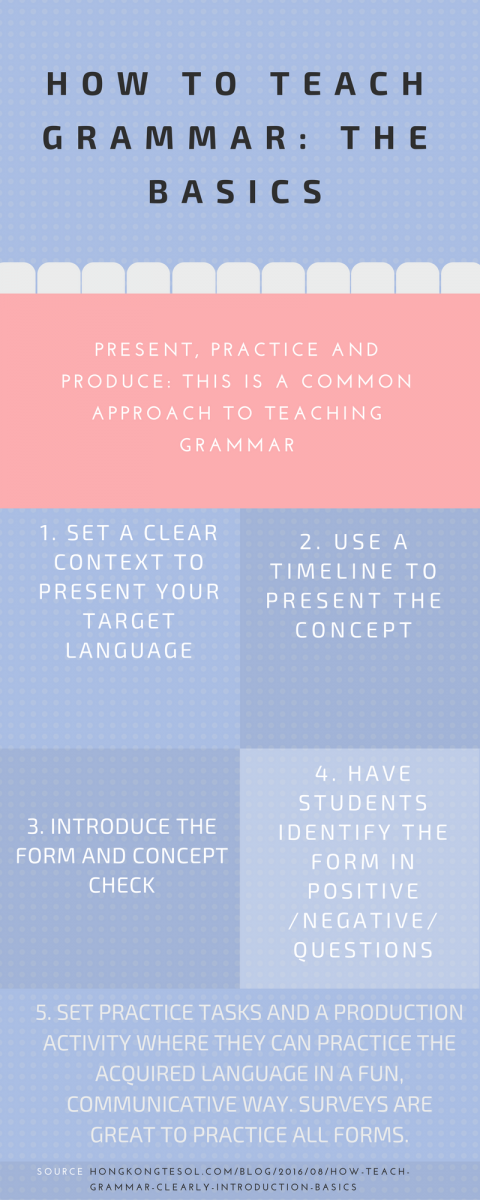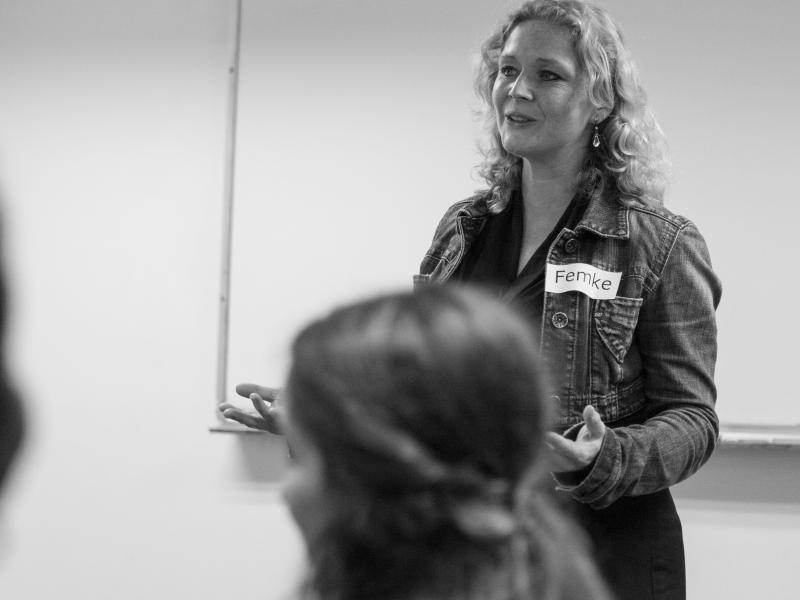10th August 2016
*Final revision by Bryan Holmes, James Pengelley and Tom Garside
Hear from some new teachers talking about their CertTESOL experience.
Often new teachers are filled with anxiety when teaching grammar. Here we outline the basic approach to clearly staged grammar lessons with a communicative, student-focused outcome. This approach is commonly called Present, Practice, Produce, and is a common starting point for teachers when they learn to teach grammar for the first time. It's also a type of lesson that is reassuring for many students in that little production is required of them early in the lesosn, yet much more is required of them in later stages as they come to terms with the meaning and forms you show them.
Register for our next Teaching skills or CertTESOL Taster Workshops here.

So, the first rule is not to freak out, but rather, ask yourself some questions. For example, let’s take modal verbs and tenses as examples; these are two of the most often taught grammatical areas in English. Modal verbs are very functional pieces of language: they alter the meaning of a sentence based on what the speaker is doing when they use them (advising, recommending, predicting, etc). First, identify the function of the target forms you are teaching, (i.e. ‘can’ and ‘would,’ both are used to make requests: 'could you pass me the salt?' or 'would you mind if I use your pen?'). Next, distinguish the register, (i.e. polite, impolite, direct or indirect or neutral?). Now choose a model sentence (which we call 'marker sentences') to show how the grammar point is used, and make a plan of how you are going to present the form(s) in a context where we naturally use that language.
When it comes to tenses, there are two times which are communicated in English: the past and the present. These times combine with aspects ( i.e. simple, continuous, and perfect) to form the many tenses of English. However, the relationship between time and tense is not clear-cut (the present perfect, for example, can have a variety of usages, such as showing a result, something recently finished, talking about life experience or something that has started in the past and is still relevant in the present).
In order to teach tenses effectively, it’s important to get to grips with using clear contexts, timelines, marker sentences, and concept check questions to elicit and check understanding of target forms. Doing so will reduce your anxiety and raise your student’s awareness of English tenses. Let’s look at an example step by step approach to present grammar.
It’s important to get to grips with timelines, marker sentences, and concept check questions. Doing so will reduce your anxiety and raise your student’s awareness of English tenses. Let’s look at an example step by step approach to present grammar.
How to present grammar
Step 1: Present a context which fits the language you are teaching.
As with modal verbs (above), this could be based on the function or meaning being communicated by the tense you are teaching. A picture, story or video clip can be used to present the concept of a tense, along with some carefully planned elicitation questions. Remember, when you are eliciting language, whether that’s vocabulary or grammar, do not use the target form in elicitation questions. This only results in students being confused by language that they do not know (the language you are teaching).
Step 2: Use a timeline to present the concept of the tense, for example:
Present Perfect Timeline – (for and since)
** Note that in this instance we are using the present perfect to indicate a past action that continues to the present. Using the present perfect like this with for indicates the period of time this action has continued, which could be shown by the dark black rectangle in the timeline above. Using it with since indicates the date it started, which could be shown by the first white circle on the left in the timeline above. In both cases, we are commenting on the fact that this past action is still happening, or impacting upon us in the present moment. Keep in mind there are other uses/functions of the present perfect...this is not the only one!!!!
Step 3: Introduce the form
Elicit and present marker sentences on the whiteboard, for example:
1. I have lived in Hong Kong for 7 years.
2. I have lived in Hong Kong since 2009.
Step 4: How do you know students understand the concept? Ask!
Ask concept check questions:
1. Do I live in Hong Kong now?
2. When did I move to Hong Kong?
3. Did this happen in the past or present?
4. Am I going to move to Hong Kong?
5. Do I use ‘for’ to show how many years or when something started?
**Remember!!!! It is better to demonstrate (timeline), and to ask binary questions (i.e. concept check questions) rather than explaining grammatical concepts. Always establish the meaning before showing/analysing the form.
Many new teachers question this rationale, and prefer to start their grammar lessons by writing "present perfect" on the board....and then they go on to ask questions like "do we use the present perfect to talk about an action in the past that continues to now?". This type of question is not nearly as useful as the specific examples above. In addition, ask yourself this: If I were president, I'd make the world a safer place. Do you understand that I am not president now? Do you understand that I am imagining my life as president in the present moment? Do you understand that I am also considering possible things I'd like to do in this imagined reality? Sure....these concepts are not all that difficult to come to terms with, but did you also know that the use of "were" in this case is the subjunctive form of the verb "to be"? Does knowing that this is the use of the subjunctive form in English help you to use the grammar in any way? What is the subjunctive anyway? If you haven't studied romance languages, where it is very common, this idea might be very foreign to you....so do students really need to know what it's called?
Step 5: How do you know if students understand the written form? Ask!
Have students identify the form (Have + Verb + pp) on the whiteboard in a different colour underneath your marker sentences. Also, elicit the positive, negative and question forms of the target language, to ensure that students know how to use the form in a range of situations
1. (Affirmative) - I have lived in Hong Kong for seven years.
2. (Negative) - I haven’t lived in Hong Kong for seven years.
3. (Question) - How long have you lived in Hong Kong?
Step 5: Set practice tasks
Now move students onto using the target forms. It's a good idea to get students working with phrases/short sentences first (in a controlled practice task) before moving onto spoken interactions or communicative production tasks.
And of course, don't forget, once you've finished production then you'll need to give feedback and error correction using a number of these ideas.
As you can see, grammar isn’t as intimidating as you may have previously thought. With a bit of staging and asking the right questions teaching can be a breeze.
Would you like to get more support to develop your teaching skills? Take a look at our upcoming CPD training sessions in Hong Kong.
Ready for a TEFL course?
Take an online 40, 60 or 120 hour course adapted from the Trinity CertTESOL qualification




